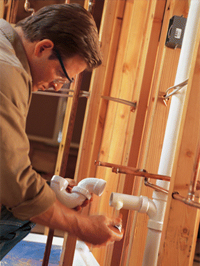Septic Systems & Plumbing Repairs in Tracy, CA
If you live outside the limits of the city and you are not connected to the main city sewer system, there has to be a way to eliminate wastewater from the home. This probably makes you the proud owner of a septic system (also called an on-lot system, on-site system, individual sewage disposal system or on-site wastewater treatment system).  This system is composed of four major parts; the main pipe, the tank, the drain field and the soil.
This system is composed of four major parts; the main pipe, the tank, the drain field and the soil.
- The pipe, or main house drain, is the avenue through which waste water leaves the house and enters the septic tank.
- The tank holds waste-water for a period of time, allowing solids to fall to the bottom and oils and other sludge to rise to the top. The sludge is decomposed by microbes present in the tank.
- Water passes from the tank into the drain field through a mesh filter at the far end of the tank.
- In the drain field, water is slowly released into the soil where it percolates down into the water table. During percolation, the remaining impurities in the water are filtered out by biological processes.
Our Plumbers Handle Septic System Maintenance
 Even though there are "maintenance free" system additives advertised by some companies, the truth is there is nothing that will break down all of the solid waste in a septic tank. The EPA recommends having your tank professionally inspected every 3 to 5 years. If you have a more involved "alternative" system with electrical float switches, pumps, or mechanical components, it needs to be inspected yearly. A qualified inspector will locate the system (if it is older and has no visible access points), uncover the access holes, check for signs of back up (this usually involves flushing the toilets), measuring scum and sludge layers, identifying leaks in the main pipe or septic tank, inspecting the mechanical components and pumping the tank if it is necessary.
Even though there are "maintenance free" system additives advertised by some companies, the truth is there is nothing that will break down all of the solid waste in a septic tank. The EPA recommends having your tank professionally inspected every 3 to 5 years. If you have a more involved "alternative" system with electrical float switches, pumps, or mechanical components, it needs to be inspected yearly. A qualified inspector will locate the system (if it is older and has no visible access points), uncover the access holes, check for signs of back up (this usually involves flushing the toilets), measuring scum and sludge layers, identifying leaks in the main pipe or septic tank, inspecting the mechanical components and pumping the tank if it is necessary.